
[dropcap]U[/dropcap]nless they’ve scouted the course in preparation, it’s unlikely many competitors at the 2015 U.S. Open will have ever seen anything remotely like Chambers Bay. More used to lush, manicured courses that conform to the PGA Tour’s ideal, this comparatively barren landscape will appear entirely alien. With acres of sand, no water hazards and a complete absence of trees (save for one fir at the back of the 15th green) the obvious association will be with the British coastline.
And yet, unlike Britain’s ancient links, Chambers Bay is eight years old and was built from scratch rather than left to evolve over centuries. And because of the present day’s need for instant recognition, Chambers Bay is altogether more theatrical and extravagant than Britain’s mellower seaside courses.
Chambers Bay was John Ladenburg’s idea. The Prosecuting Attorney for Pierce County (home to Chambers Bay), Ladenburg was elected County Executive in 2000. Before closing out his second and final term in office, Ladenburg was determined to make golfing use of a mostly derelict 600-acre parcel overlooking Puget Sound that the county purchased in 1992.
The place was a mess; covered in scrub, sand, ponds and debris from 100 years of sand and gravel mining, and on which the County’s water treatment plant stood.
The persuasive Ladenburg convinced the county to spend another $24 million on land that had already cost $33 million. He interviewed 56 design firms, but ultimately, the vision of Robert Trent Jones Jnr. matched Ladenburg’s the closest, and local favourite, Tacoma-based John Harbottle, was edged out.
Ground was broken in October 2005 and, over the course of the next two years, an amazing 100,000 truckloads of sand were removed from the site, cleaned, and returned for Trent Jones and his two close associates Bruce Hamilton and Jay Blasi to pile, shape, push, sculpt, cajole, and nudge into place.
Ladenburg knew Bethpage Black in New York had been the only municipal course to have hosted the U.S. Open (Torrey Pines would follow in 2008). He also knew that if the U.S. Open was to come to the Pacific Northwest for the first time, he couldn’t compromise on a single detail.
The course would be all fescue like the Open venues, it would be walking-only, and it would be called Chambers Bay. The course opened in June 2007 and seven months later, the USGA announced it would be taking the national championship there.
The U.S. Amateur Championship served as a trial run. In August 2010 the best amateurs in the world competed on a parched and fiery Chambers Bay that took the concept of firm and fast to the extreme.
The event was a success for winner Peter Uihlein, but chief among a list of potential problems were the greens. Ryan Moore, from nearby Puyallup, played the course in 2010 and phoned the USGA’s Director of Rules and Competition Mike Davis (now Executive Director) to voice his concerns. The putting surfaces were slow and bumpy, he said, not even close to good enough for a U.S. Open.
In June 2012, Eric Johnson was finally appointed the new Director of Agronomy. Johnson, who had spent four years at Spyglass Hill on the Monterey Peninsula and nine years at the Bandon Dunes Golf Resort in Oregon, soon hired Josh Lewis, himself a former Bandon Dunes man, as his first assistant.
The difference between 2010 and 2015 is striking and a relief to Tacoma News Tribune writer Todd Milles. “I wouldn’t say we were getting nervous before Eric arrived,” he says, “but Eric and Josh have done an amazing job.”
Lewis predicts the rough will live up to traditional U.S. Open thickness. “We haven’t really ever seen thick, dense rough here before, but closing the course and reducing the traffic for a few weeks will allow it to develop.”
The course will play to a par of 70, but keeping all concerned on their toes, the front nine could play to 34 or 35, and the back nine to 35 or 36. Par and exact hole yardages will be provided daily for each of the four rounds. The course can reach almost 7,900 yards but will likely play somewhere between 7,200 and 7,700 yards, depending on weather conditions. Never have golfers headed to a U.S. Open with so many unknown factors to keep them off balance.
Firm, thick rough is probable, but sand everywhere you turn is confirmed, with possibly over 7,500 yards to navigate; with even 10 miles per hour of wind, Chambers Bay could become golf’s new monster.
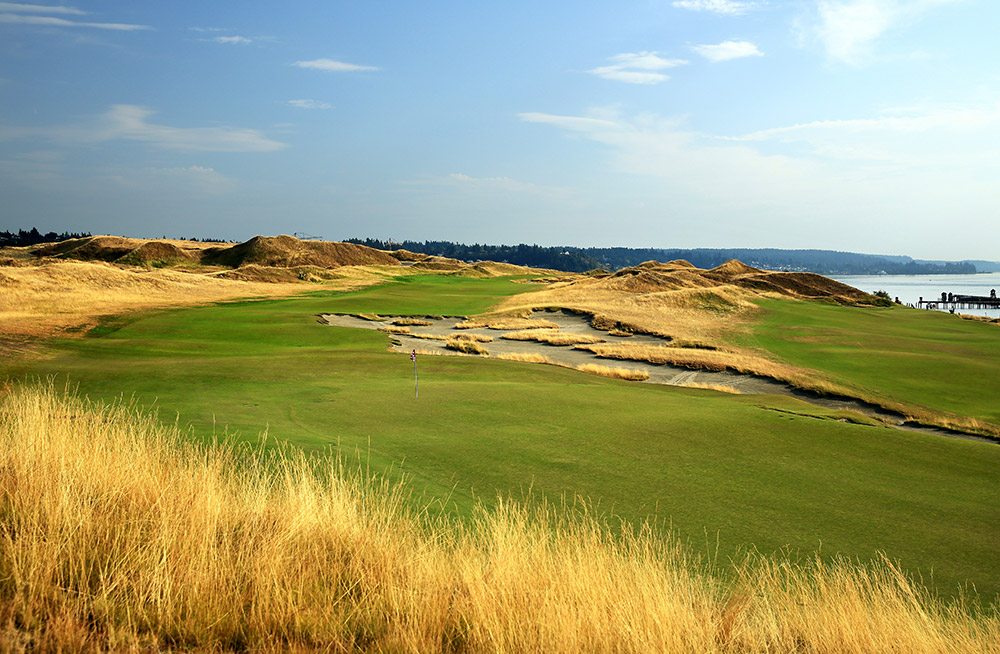
598 yards, par 5
The first heads west toward the Sound and McNeil Island, a 60-foot high dune running down the right side of the hole. Far too many approaches during the 2010 U.S. Amateur trickled 50 yards left of the green so Robert Trent Jones returned in 2011 to flatten the approach. The USGA has the option of playing the hole as a par four or par five.
399 yards, par 4
The name pays tribute to the fabulous 14th at Royal Dornoch, but is also a reference to Fox Island out in the Sound. One of only two par fours under 400 yards, the second should be a decent birdie opportunity for anyone getting a good drive away. The hole bends a little left so the shortest approach is from that side, but a 100-yard-long bunker lies in wait.

198 yards, par 3
The first short hole on the course was lengthened considerably when Trent Jones returned in 2012. The hole will likely play downwind, meaning elite ball-strikers will only need a mid-iron to get home. There’s a huge bunker to the left so the ideal shot will be a baby draw that pitches on the front right edge of the green and uses the slope towards the hole.
495 yards, par 4
The fourth is named after Hazard Stevens, who in 1870 became one of the first climbers to reach the top of 14,411-foot Mt Rainier, 50 miles southeast of the course. The fairway bends slightly right around another huge sandy area and it is here that Chambers Bay really starts getting tough. Anyone leaving the green of this uphill 495-yard hole with a four will not be losing any ground to the field.
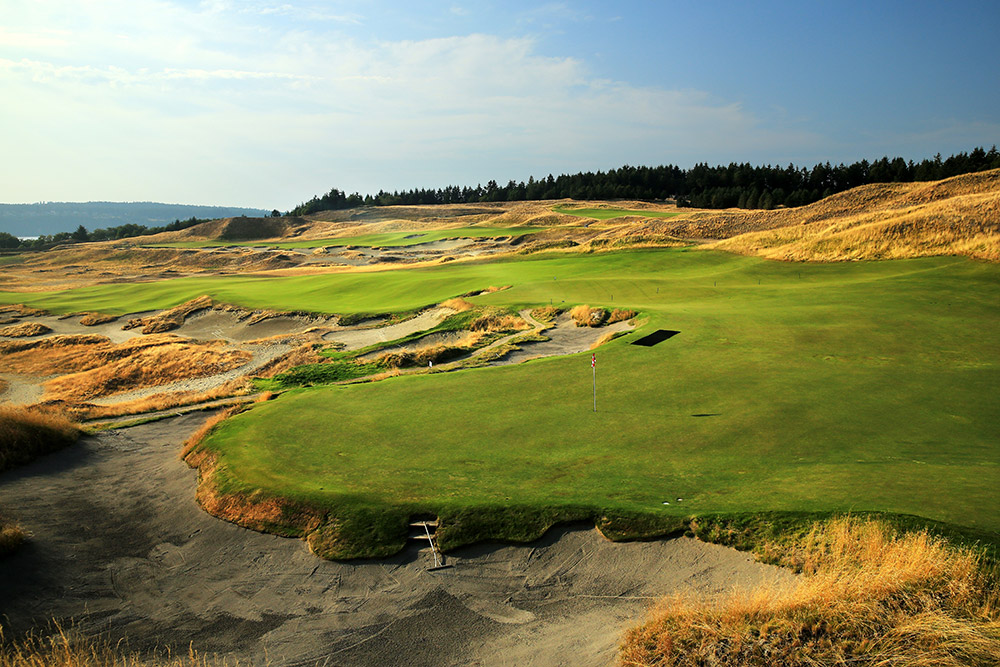
488 yards, par 4
From the high tee, the views of Puget Sound will give players a moment’s pause before they attempt to rifle one between two huge bunker complexes either side of the fairway. A deep, but more conventional-looking bunker protects the front of the green, but big-hitters who take advantage of the downhill tee shot should only have a short-iron second.
495 yards, par 4
The terrific sixth bends left to right and rises towards the green. The fairway is mercifully devoid of bunkers, but to set up a straightforward approach that can be brought in low to run up the green, the player must find the left half of the fairway. This hole will likely play into the wind – a strong par 4.
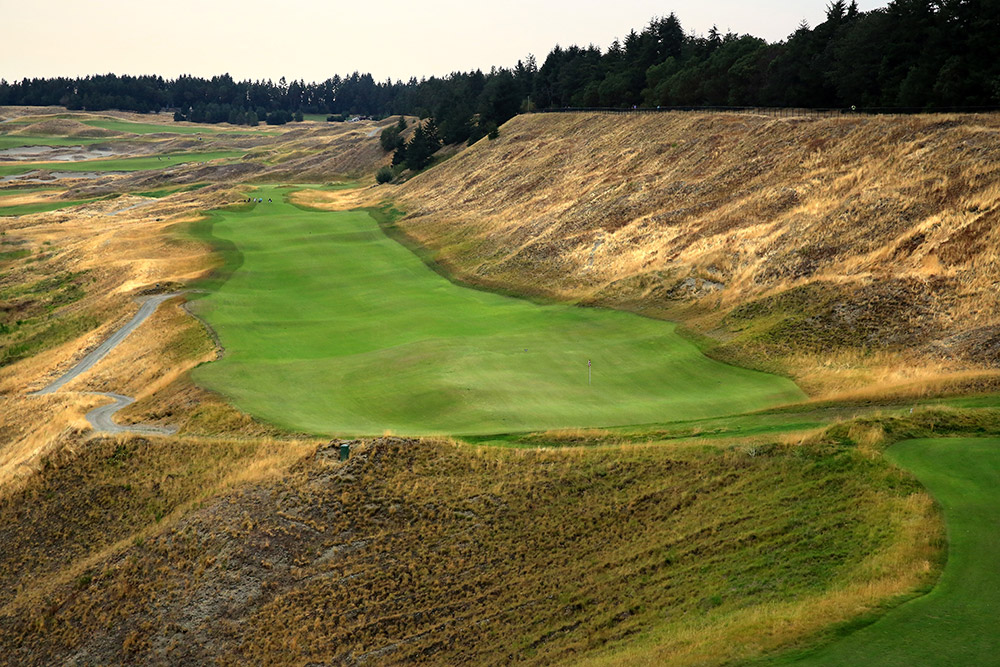
508 yards, par 4
If the sixth is tough, wait for the seventh. ‘Humpback’ (there are two hummocks short of the green, and humpback whales have often been seen in the South Sound) bends around a huge area of sand, making it something of a Cape hole where the brave will risk finding sand off the tee in search of a shorter approach.
614 yards, par 5
This monstrous, straightaway, uphill par five was tweaked after the 2010 U.S. Amateur as too many balls missed the green to the right, running 50 yards back down the hill. The green surrounds were flattened and there are no bunkers here. However, the uphill slope, prevailing wind and multi-tiered green will keep the average score around five.

224 yards, par 3
From 100ft above the green, club selection is challenging, especially if the prevailing wind is blowing left to right. A typically large bunker guards the right side of the green, and must be carried from a new, lower tee installed in 2012. The challenge from the two tees is very different; finesse will be needed from the high tee, strength from the lower.
436 yards, par 4
The back nine starts with an absolute gem; a medium-length par four moving steadily uphill between two enormous dunes, both roughly 200 yards long. Hybrids and long-irons will be favoured on the tee as the fairway narrows the closer you get to the green, which is wedged beautifully between the two converging sand hills.
537 yards, par 4
A really long par four which may be eased by the prevailing wind. Carry the rough-covered dune in the centre of the fairway, and players will have a long-to-mid iron approach to a heavily contoured green which banks significantly from right to left. The large, sandy area short and right of the green should only trouble those in the rough off the tee.
331 yards, par 4
An exciting short par four, the 12th runs uphill between dunes that stretch the length of the hole. The only straight putt on the wildly-sloping putting surface is a tap-in, which players could conceivably leave themselves after a bold, perfectly-struck draw off the tee. The name refers to the Tacoma Narrows Bridge, which collapsed in a violent storm in 1940.
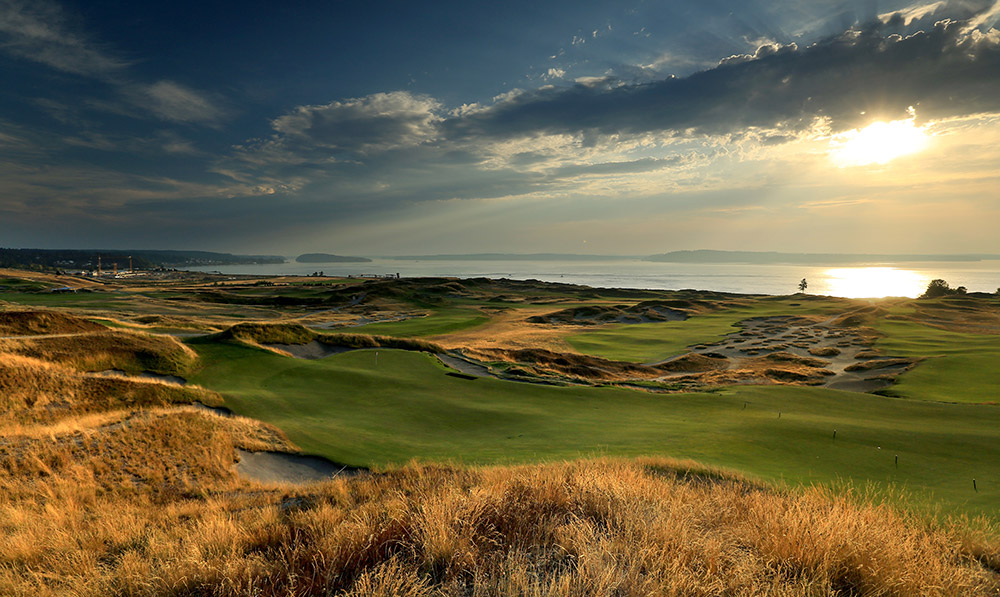
534 yards, par 4
The fairway is the widest on the course, but that really is the only thing keeping the uphill, severely bunkered 13th from being downright evil. A huge sandy waste area defends the right side but anyone sniffing it with their tee shot will leave a much shorter approach. Wherever players drive the ball, par fours will be prized commodities.
546 yards, par 4
Another par four over 500 yards, the 14th is at least downhill. It curves right to left around a massive sandy area which lines the entire left side of the hole, though a conventional bunker, named ‘Bobby’s Bunker’ after Trent Jones, lurks in the middle of the fairway, about 300 yards off the back tee, ready to trap anyone not attempting to carry sand on the left.
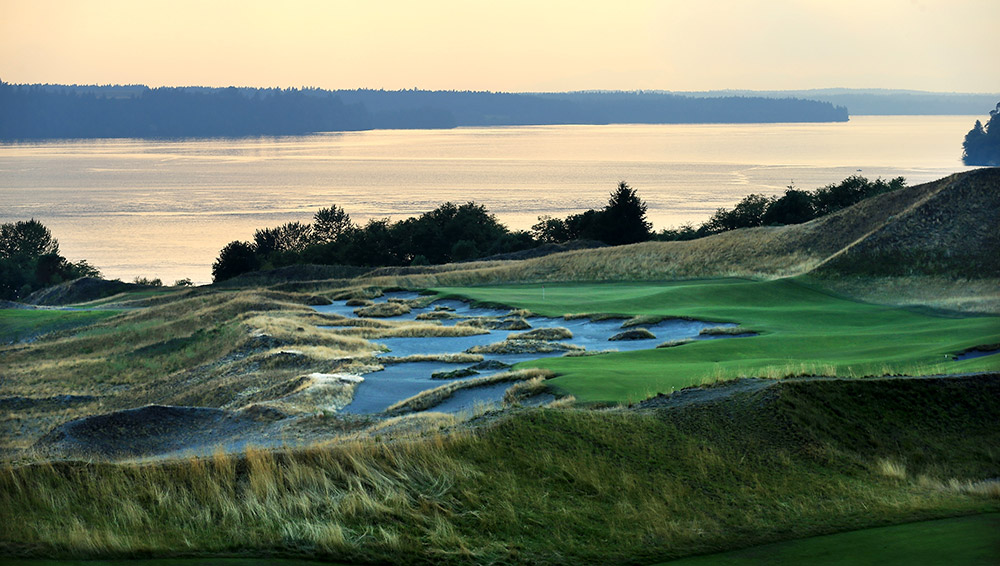
123 to 246 yards, par 3
The stunning par-three 15th plays downhill towards the Sound and the only tree within the course’s boundaries, a 50-foot Douglas Fir named ‘Lone Fir’, which is fast becoming the course’s iconic landmark. The green is surrounded by sand, which won’t be a problem when the tee is set at 123 yards, but will take some avoiding from the 246-yard marker.
423 yards, par 4
Another glorious challenge, the 16th runs adjacent to the Sound and railroad tracks. The hole curls from left to right, the fairway sloping from the left towards another long, sandy area that extends down most of the right side. The smallest green on the course narrows to a thumbnail at the back, offering an exciting pin position for the closing stretch.

172 to 218 yards, par 3
The last par three is another memorable one-shotter with railroad, water and plenty more sand, both groomed and unkempt. Two distinct teeing areas demand either a drop shot with a short-ish iron, or level shot with more club. The green is split into clearly defined areas, ensuring plenty of awkward putts. Two-putt pars will work just fine.
525 to 604 yards, par 4/5
Tahoma is the Indian name for Mt. Rainier and is a fitting tag for this monumental finishing hole. A 10-foot deep bunker sits in the middle of the fairway, 120 yards short of the extremely undulating green. The USGA’s Mike Davis wanted it there to complicate the second shot when the hole plays as a par five.
Follow Us On


| Cookie | Duration | Description |
|---|---|---|
| cookielawinfo-checkbox-analytics | 11 months | This cookie is set by GDPR Cookie Consent plugin. The cookie is used to store the user consent for the cookies in the category "Analytics". |
| cookielawinfo-checkbox-functional | 11 months | The cookie is set by GDPR cookie consent to record the user consent for the cookies in the category "Functional". |
| cookielawinfo-checkbox-necessary | 11 months | This cookie is set by GDPR Cookie Consent plugin. The cookies is used to store the user consent for the cookies in the category "Necessary". |
| cookielawinfo-checkbox-others | 11 months | This cookie is set by GDPR Cookie Consent plugin. The cookie is used to store the user consent for the cookies in the category "Other. |
| cookielawinfo-checkbox-performance | 11 months | This cookie is set by GDPR Cookie Consent plugin. The cookie is used to store the user consent for the cookies in the category "Performance". |
| viewed_cookie_policy | 11 months | The cookie is set by the GDPR Cookie Consent plugin and is used to store whether or not user has consented to the use of cookies. It does not store any personal data. |